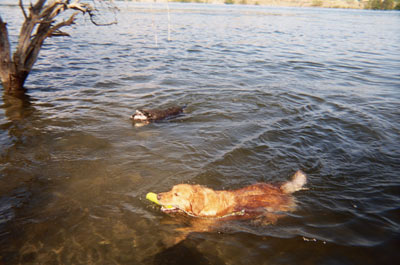 By Jane Lemon Mott By Jane Lemon MottSo you donít have a dog who
needs swimming lessons? Enjoy this article anyway. You
never know when you, your family, or a friend may need
advice on a water-shy dog!
After 43 years, I can still see that little
six-month-old yellow cocker spaniel puppy, Peaches,
leaping from our boat while we were 50 yards from shore.
My panic was that of an 11- year-old who believed
that because we had not taught that little girl to swim
that she would surely drown before making it to dry
land.
Well if Peaches didnít know what she was doing, she
learned in a hurry. Bobbing and paddling for all she was
worth, she cut a beeline to shore and amazed us all with
her speed and endurance.
Peaches was a natural swimmer, but that is not true
of all dogs ó even many who, by breed, are thought to be
able and willing to swim. Some dogs may need to have a
little help getting a good start in the water.
Giving a dog swimming lessons may sound a bit odd to
some, but I believe that it is part of any good training
program ó especially if you intend to take your K9
friend with you on water excursions.
There are a lot of good instructional Web sites about
water training your dog, but there are elements that
remain constant through all the sites that I have
searched.
They are as follow:
- If itís possible, start when your dog is young,
especially if you own a larger breed that will be hard
to handle later.
- Donít think that because you have a breed known to
be water lovers that your dog will neatly follow all
the traits of the breed.
- Keep in mind that there are fear stages in puppy
development that can cause a bad experience to hamper
successful training. In other words, donít do anything
that will scare your dog like dropping him/her into
the water to "sink or swim."
- Choose a safe training area where the water is not
too cold, and there is a gradual slope to the bottom.
- And last, but not least, is #5. This is something
that I have witnessed twice and have been amazed by
both times. If possible, take an older, more
experienced dog with you to lead the way.
I have witnessed my yellow Labrador retriever mentor
a black lab puppy who would not get into the water.
After 20 minutes, that puppy was swimming out beside my
dog to retrieve sticks that they would bring back
together.
The puppyís owners were delighted as they had been
thinking that their water dog was a water dud.
The second time that I witnessed this old dog/new dog
mentoring is a little different and goes back to
expectations of breeds. After the loss of our Labrador,
we bought a golden retriever puppy(Ginger).
She was a great retriever on land at an early age but
surprised us by not wanting to go into the water ó even
to go after her favorite toy. Finally, after watching
our frustrating water training efforts with our new
friend, our eight-year-old terrier mix (Crunchy, who
hates the water) began the mentoring process and had
that puppy swimming like the water dog (we thought) she
born to be.
To this day, when the float toy is thrown into the
water, the terrier and the golden race to the shore
together, but the terrier stops before her tummy hits
the cold water.
What if you cannot find an older dog to assist in
training? What are cross-species friends for but to help
each other. Thatís right, you can take on the role of
mentor.
Use the tips Iíve given plus an abundance of common
sense and you may succeed as well as that old dog in
teaching new tricks!
And, important too are dog-swimming-lesson safety
tips for humans: Wear clothing that will protect your
skin from accidental dog scratches and stay in shallow
water as a panicked dog can drown a human.
Train in quiet water away from river currents. If you
water train in a swimming pool ( yes, some people do),
be sure your pet knows the way to get out.

|
 July
2006
July
2006 July
2006
July
2006